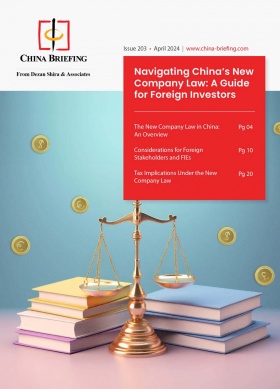April 2024 Economic Roundup – Industrial Output and Foreign Trade Continue to Spur Recovery
China’s economy in April 2024 saw strong activity in supply-side sectors as industrial and manufacturing output surged. Meanwhile, foreign trade experienced a major rebound following a fall in March, with growth in imports reaching a year-long high. At the same time, slowing growth in retail sales and low inflation signals weak demand-side recovery and continues to put pressure for more policies to stimulate consumption.
China’s National Bureau of Statistics (NBS) has released the economic indicators for April, providing a snapshot of the performance of industry, services, consumption, foreign trade, and investment, among others.
The data shows healthy growth in the industrial sector, with manufacturing in several key sectors accelerating from the previous month amid healthy economic activity. In addition, foreign trade surged on the back of the strongest imports recorded in a year, reversing a decline in March. However, retail sales and consumption continue to slow amid weak domestic demand, underscoring concerns about the resilience of consumer spending despite broader economic improvements.
We look at what the data says about China’s economy in April 2024 and the country’s growth prospects for the rest of the year.
Growth in industrial value-added output accelerates
China’s industrial sector enjoyed healthy growth in April on both a year-on-year basis and compared to the previous period in 2024.
Total industrial value-added output accelerated to 6.7 percent year-on-year in April, two percentage points faster than the previous month. In the first four months of 2024, the total value-added output of industrial companies above a designated size (those with a main business income of over RMB 20 million (US$2.76 million)) increased by 6.3 percent year-on-year, accelerating by 0.2 percent in the period from January to March 2024.
The value-added output of the manufacturing industry increased 7.5 percent year-on-year in April, accelerating from 5.1 percent year-on-year growth in March. Meanwhile, several key manufacturing sectors experienced high levels of growth in added value output, including:
- equipment manufacturing, which increased by 9.9 percent year-on-year;
- high-tech manufacturing, which increased by 11.3 percent year-on-year;
- automobile manufacturing, which grew by 16.3 percent year-on-year;
- railway, shipbuilding, aerospace, and other transportation equipment manufacturing, which increased by 13.2 percent year-on-year; and
- computer, communications, and other electronic equipment manufacturing, which grew by 15.6 percent year-on-year.
In the first quarter of 2024, the total realized revenue of industrial companies above a designated size reached RMB 1.5 trillion (US$207.2 billion), up 4.3 percent from the same period in 2023.
Meanwhile, private companies and foreign-invested enterprises (FIEs) also saw significantly improved performances, growing at faster rates than state-owned enterprises (SOEs); the value-added output of private companies and FIEs (including Hong Kong, Macao, and Taiwan-invested enterprises) grew 6.3 percent and 6.2 percent year-on-year, respectively, compared to 5.4 percent year-on-year growth in the public sector.
Service industry maintains expansion with core sectors recording strong performance
In April, the service industry business activity index was 50.3 percent, indicating an expansion, but decreasing slightly from 52.4 percent in March. Many core service industries recorded a very healthy performance, with the business activity index of railway transportation, road transportation, postal service, telecommunications, radio and television, and satellite transmission services all exceeding 55 percent.
Growth in the service industries slowed slightly in April compared to the previous month. The services production index in April grew 3.5 percent year-on-year, decelerating from 5 percent in March. Nonetheless, several industries experienced healthy growth, with the service production index of the following sectors all exceeding the national average:
- Information transmission, software, and IT services increased by 10.8 percent year-on-year;
- Leasing and business services increased by 6.1 percent year-on-year;
- Finance increased by 5.4 percent year-on-year; and
- Transportation, warehousing and postal industries increased 4.3 percent year-on-year.
Between January and April 2024, the services production index increased by 5 percent from the same period in 2023. Meanwhile, the revenue of service companies above a designated size (those with a main business income of over RMB 20 million) grew 8.5 percent year-on-year in the first quarter of the year.
Slowing retail sales and low inflation signal weak domestic demand
Total retail sales of consumer goods grew 2.3 percent year-on-year in April to reach RMB 3.56 trillion (US$491.64 billion). This marks the fifth consecutive month of decelerating growth and a slowdown from 3.1 percent year-on-year growth in March.
Of the total retail sales, merchandise sales accounted for 89 percent, growing 2 percent year-on-year to reach RMB 3.2 trillion (US$441.9 billion). Meanwhile, catering revenue reached RMB 391.5 billion (US$54.1 billion), up 4.4 percent year-on-year.
Between January and April 2024, total retail sales reached RMB 15.6 trillion, up 4.1 percent from the same period in 2023. Retail sales of services increased by 8.4 percent year-on-year in the first four months.
Meanwhile, online retail sales amounted to RMB 4.41 trillion over this same period, accelerating 11.5 percent year-on-year, of which online retail of physical goods accounted for around 84 percent (online sales of physical goods also accounted for 23.9 percent of total retail sales). Of these physical goods, online sales of food, clothing, and daily necessities increased by 19.2 percent year-on-year, 10.5 percent year-on-year, and 9.8 percent year-on-year, respectively.
Inflation in April remained low amid weak domestic demand, with the national consumer price index (CPI) increasing just 0.3 percent year-on-year, although this is a 0.2 percentage point increase from the previous month. Core CPI, excluding food and energy prices, rose by 0.7 percent year-on-year, an increase of 0.1 percentage points from the previous month. From January to April, the national consumer price increased by 0.1 percent year-on-year.
The price of food, tobacco, and alcohol decreased by 1.4 percent year-on-year, driven largely by significant drops in the price of fresh fruit (down 9.7 percent year-on-year). Pork prices, a significant driver of consumer prices in China, increased by 1.4 percent year-on-year following a 2.4 percent year-on-year decrease in March, impacting the CPI increase by about 0.02 percentage points.
Meanwhile, the prices of some products increased, albeit relatively little:
- Clothing prices increased by 1.6 percent year-on-year;
- Housing prices increased by 0.2 percent year-on-year;
- The price of daily necessities and services increased by 1.4 percent year-on-year; and
- Healthcare prices increased by 1.6 percent year-on-year.
Foreign trade surges, reversing March decline
China’s foreign trade in April accelerated 8 percent year-on-year to a total of RMB 3.64 trillion (US$502.69 billion). This is a sharp reversal of the 1.3 percent drop recorded in March and an acceleration of the 5 percent average year-on-year growth recorded in the first quarter. The growth in April was spurred primarily by a surge in imports, which increased 12.2 percent year-on-year to reach RMB 1.56 trillion (US$215.44 billion), the highest growth rate since April 2023. Meanwhile, exports grew 5.1 percent year-on-year, a reversal from the 3.8 percent fall recorded in March, reaching a total of RMB 2.1 trillion (US$290 billion).
China maintained a trade surplus of RMB 513.5 billion (US$70.9 billion) in April.
Between January and April, the total import and export volume of goods reached RMB 13.81 trillion (US$1.91 trillion), an increase of 5.7 percent from the same period in 2023, of which exports were RMB 7.8 trillion (US$1.1 trillion), up 4.9 percent, and imports were RMB 5.99 trillion (US$827.2 billion), up 6.8 percent.
Exports of mechanical and electrical products increased by 6.9 percent year-on-year and accounted for 59.2 percent of total exports.
Navigating economic imbalance for sustained growth
The April 2024 economic indicators from China’s NBS present a mixed yet cautiously optimistic outlook for the nation’s economic trajectory. The industrial and manufacturing sectors continue to be the engines of growth, demonstrating robust performance and significant year-on-year gains. Foreign trade has also rebounded strongly, reversing the decline observed in March and highlighting China’s resilience in the global market.
However, the persistent weakness in domestic consumption remains a concern. The deceleration in retail sales growth and low inflation underscore the challenges in stimulating domestic demand. This imbalance between strong supply-side growth and tepid demand-side performance suggests that while industrial output and foreign trade can drive short-term recovery, sustainable long-term growth will require a more balanced economic environment.
About Us
China Briefing is one of five regional Asia Briefing publications, supported by Dezan Shira & Associates. For a complimentary subscription to China Briefing’s content products, please click here.
Dezan Shira & Associates assists foreign investors into China and has done so since 1992 through offices in Beijing, Tianjin, Dalian, Qingdao, Shanghai, Hangzhou, Ningbo, Suzhou, Guangzhou, Dongguan, Haikou, Zhongshan, Shenzhen, and Hong Kong. We also have offices in Vietnam, Indonesia, Singapore, United States, Germany, Italy, India, and Dubai (UAE) and partner firms assisting foreign investors in The Philippines, Malaysia, Thailand, Bangladesh, and Australia. For assistance in China, please contact the firm at china@dezshira.com or visit our website at www.dezshira.com.
- Previous Article China’s Chocolate Market – Trends and Industry Overview
- Next Article Greater Bay Area (GBA) IIT Subsidy Kicked Off in Shenzhen 2024








